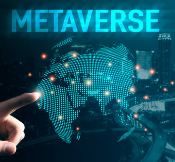Digital Cities: Community Building in the Metaverse
Digital Cities: Community Building in the Metaverse
Edited by Dr. Terry Kibiloski
As virtual spaces gain traction, the prospect of cities moving into the metaverse grows increasingly viable, which can help expand Web3 via community-building and creative collaboration.
The rise of metaverse technologies has brought about a wave of interest in virtual real estate. Many platforms now offer programmable spaces, which brands have leveraged to enrich the customer experience, and plans as expansive as virtually immersive cities, or “metacities,” are currently underway in sectors ranging from tourism to environmental preservation.
While gaining headway, the metaverse still remains a novel concept, leaving many potential investors wondering about the diversity of virtual spaces and their specific advantages. To clear the air, Tomas Nascisonis, CEO of Crypto House Capital, a virtual real estate firm currently building the first MetaReal residential skyscraper in the metaverse – Skylum, speaks of the potential of metacities as a social and creative catalyst.
Metareal spaces for community-driven development
Brands seeking a presence within a metaverse find themselves tasked with community building. Currently, the nascent technology and ever-evolving concepts prevent mass appeal.
According to Nascisonis, physical buildings with virtual counterparts, or “digital twins,” a concept he defines as a “metareal city,” will have the advantage of appealing to existing communities. A livable space provides immediate use for people with shared interests and goals. Given this, communities will grow more vibrant as they move into the digital counterpart.
With next-gen technology, users will be able to conduct real-life activities with customizable avatars. “To scratch the surface, people will have fun by exploring the possibilities of concerts, lectures, fashion shows, nightclubs, and art galleries within a metareal city. A new way of expression will emerge when we combine the online and offline sides of our lives, and people will want to explore this possibility of living and experiencing both worlds and taking the best from them,” says Nascisonis.
Next-gen technology to foster creativity
Aside from attracting existing communities, a city in the metaverse will provide users with new means of creative expression. As AR/VR devices evolve, residents and users will have the technology to author digital content.
In this light, users can share creative projects of all shapes and sizes, overcoming real-world limitations such as location and the expense of creating physical objects. Further, the ability to instantaneously connect, create, and exchange content in close digital proximity will strengthen creative collaboration. With this in mind, the virtual counterpart offers a space bounded only by the imagination.
“In our opinion,” concludes Nascisonis, “the most interesting area to work on is enabling people to express themselves. That’s why we think the community we’ll gather around the metareal city will be expected as people shift from web2 to web3, from centralized to decentralized economy and ownership.”






